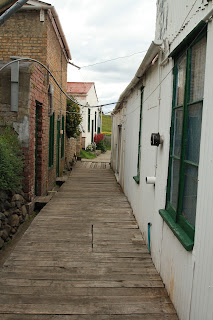A DAY ON THE FARM-the Estancia in Patagonia/ Tierra del
Fuego Feb. 2013
After having reached ‘the end of the road’ I had an
opportunity to visit one of the most notable Estancias in Patagonia/ Tierra del
Fuego. The expansive sky mirrors the expansive territory that this Estancia
encompasses. Nothing is small down here, everything is big and the distances
are hard to comprehend. Take for example this Estancia. I can’t get my head
around an Estancia that encompasses as far as the eye can see- from the distant
mountains to all the islands in the Beagle Channel. We’re talking about 250,000
hectarias (500,000 plus acres).
The story of Harberton, the name of this Estancia, begins
with Thomas Bridges an abandoned baby found under a bridge in Bristol, England
about 1845. He had embroidered on his clothes a “T” therefore Thomas Bridges.
He was adopted by an Anglican minister and in a short time (1856) he moved with
his family to the Malvinas Islands (Falklands) . Within 3 years some
missionaries were sent from the Malvinas to the area around Ushuaia and were
all killed during the first religious ceremony they had but the local
inhabitants called Yamanas.
In 1859 he set out as a very young man and landed in
Ushuaia. Soon thereafter he established the Estancia. Since he had grown up
speaking the ´Yamana language he was the first white man to live and establish
residency in Patagonia. He was accepted by the locals.
One of his most
outstanding legacies was to create a ´Yamana dictionary of 35,000 words. This
work still stands as the only definitive and authorative source for information
on this language.
He was the first to introduce sheep in the area and also the
vaccination of cows. Further information can be found in the wonderful book
called “The Uttermost part of the Earth”. I read that book some 25 years ago
and so, being in the area, I had to visit and see the Estancia.
A number of interesting items can be found on the Estancia
including whale bones, animal skins, sheep shearing equipment and of course the
introduction of ‘modern technology’ from England in the late 1800’s. For
example, the main houses were the first pre-fabricated houses in the Patagonia
and beyond. The houses were built in England and each piece was numbered, the
house dismantled and shipped to the Estancia where it was re-built. Local
indigenous people who had been taught carpentry helped with the construction.
They now wore clothing (previously, as noted by Darwin, the indigenous people
wore no clothing, only wrapped in Guanaco skins and living a migratory life
style hunting and fishing.) (Darwin called the people savages and cannibals.
Bridges set out to change the world’s opinion by showing a different side of
the culture).
Here are some photos of the Estancia as it currently exists.
 The garden with seasonal flowers, strawberries, lettuce and other veggies you'd find in a northwest garden in summer.
The garden with seasonal flowers, strawberries, lettuce and other veggies you'd find in a northwest garden in summer. The pre-fab house built in England, taken apart and shipped with numbered pieces. Pretty good for the 1870's.
The pre-fab house built in England, taken apart and shipped with numbered pieces. Pretty good for the 1870's. Wood is the prime source for heating. You can never have enough though it is very plentiful . This pile was about 12' high.
Wood is the prime source for heating. You can never have enough though it is very plentiful . This pile was about 12' high. A view looking down on the harbor. Although there is a road (85 kms.of dusty road) it is sometimes easier to avoid the mountain pass (had snow on it last week) by taking the launch through the Beagle Straits to Ushuaia.
A view looking down on the harbor. Although there is a road (85 kms.of dusty road) it is sometimes easier to avoid the mountain pass (had snow on it last week) by taking the launch through the Beagle Straits to Ushuaia.





No comments:
Post a Comment